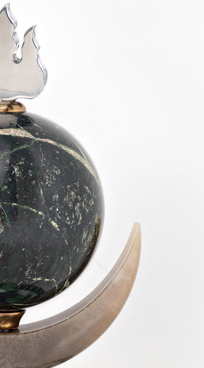According to certain sources, clinochlore was first described in 1888 by the Russian mineralogist Nikolay Ivanovich Koksharov in the scientific work ‘Materials for Mineralogy of Russia’. Other sources claim that the first mention of the existence of this gem was attributed to the American geologist William Blake in 1851 who gave it the name.
The scientific name of the stone comes from the Greek words ‘clino’ (tilt) and ‘chloros’ (green). The stone was named so because of the color and bizarre shape of the crystals. They are tilted at different angles. A characteristic feature of the gem is a variety of shades and amazing patterns. Most often, the stones are olive-green in color. Much less often, there are instances of pink, blue, and purple shades. In nature, the mineral occurs in the form of scales, plates, and tabular crystals, as well as aggregates, rosettes, and drusen.
The clinochlore was initially used for jewelry purposes only after the end of World War II in the second half of the 20th century. Then the people called one of its varieties, often used in jewelry, serafinite. This name was given to it for the similarity of its iridescent fibers with feathers. There was also a legend about the origin of serafinite. According to it, one day the six-winged angel Seraphim found out about a girl in love who was treacherously betrayed, and for the first time in his long existence, he began to cry, because angels have no right to help mortals. On earth his tears turned into green crystals. This was the clinochlore.
Serafinite is an ornamental stone. Boxes and statuettes are made from it. Serafinite looks very beautiful in jewelry. Due to its iridescent color, it looks very expressive. Most of the clinochlore deposits are located in Russia, namely: in Akhmatovskaya Mine, the Chelyabinsk and Sverdlovsk Regions, and other areas. It is also found in Spain, Switzerland, Austria, Scotland, Greece, Japan, USA, Pakistan, and Korea. As for serafinite, it is extracted at the Korshunovskiy Iron Ore Deposit in the Irkutsk Region.
The scientific name of the stone comes from the Greek words ‘clino’ (tilt) and ‘chloros’ (green). The stone was named so because of the color and bizarre shape of the crystals. They are tilted at different angles. A characteristic feature of the gem is a variety of shades and amazing patterns. Most often, the stones are olive-green in color. Much less often, there are instances of pink, blue, and purple shades. In nature, the mineral occurs in the form of scales, plates, and tabular crystals, as well as aggregates, rosettes, and drusen.
The clinochlore was initially used for jewelry purposes only after the end of World War II in the second half of the 20th century. Then the people called one of its varieties, often used in jewelry, serafinite. This name was given to it for the similarity of its iridescent fibers with feathers. There was also a legend about the origin of serafinite. According to it, one day the six-winged angel Seraphim found out about a girl in love who was treacherously betrayed, and for the first time in his long existence, he began to cry, because angels have no right to help mortals. On earth his tears turned into green crystals. This was the clinochlore.
Serafinite is an ornamental stone. Boxes and statuettes are made from it. Serafinite looks very beautiful in jewelry. Due to its iridescent color, it looks very expressive. Most of the clinochlore deposits are located in Russia, namely: in Akhmatovskaya Mine, the Chelyabinsk and Sverdlovsk Regions, and other areas. It is also found in Spain, Switzerland, Austria, Scotland, Greece, Japan, USA, Pakistan, and Korea. As for serafinite, it is extracted at the Korshunovskiy Iron Ore Deposit in the Irkutsk Region.



